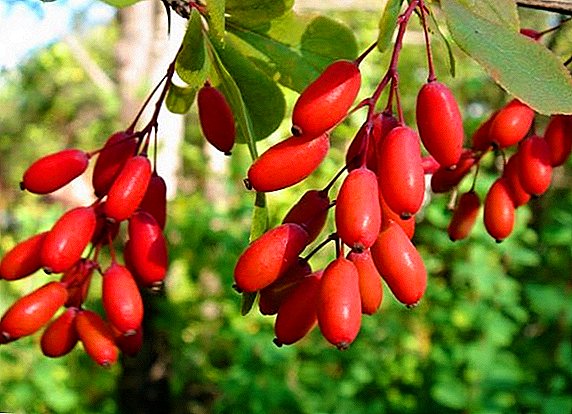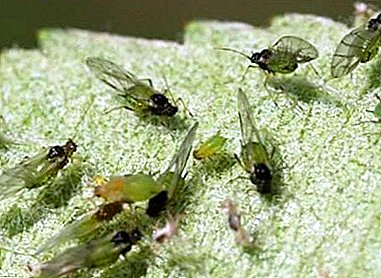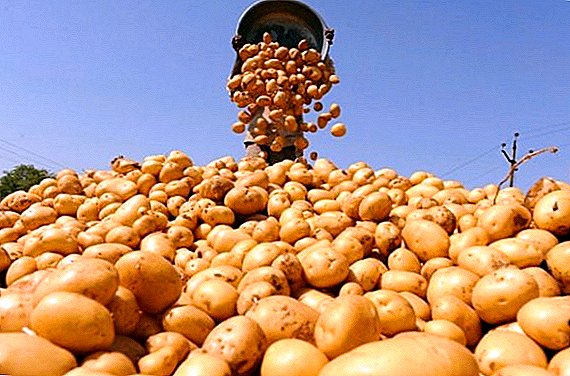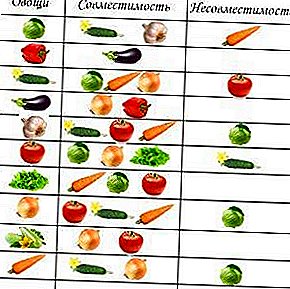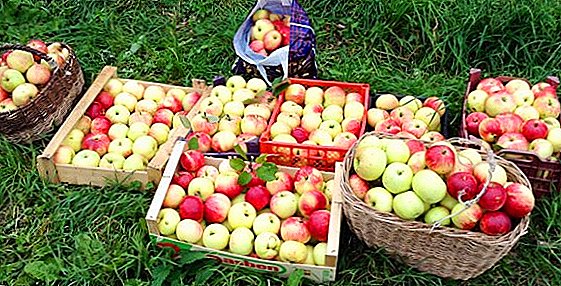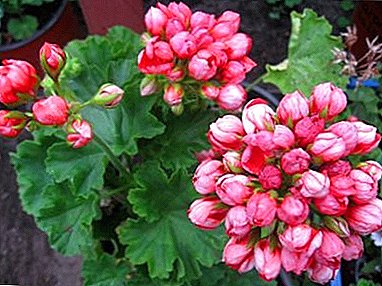
Tulip pelargonium is one of the most beautiful representatives of this family.
The name of the flower was due to external similarity with the unopened tulip.
Often this variety is confused with rozbudna geraniums. But these plants are completely different.
In this article we will analyze the features of a variety of tulip-like pelargonium.
Botanical description of varieties, history and photo
For the first time this variety of Pelargonium appeared to the general public in the second half of the twentieth century - in 1966. This event occurred in the United States, in the nursery Andrea. The very first variety was given the name in honor of one of the members of the breeders family - Patricia Andrea. In subsequent years, this family of flower growers brought several more varieties.
It is worth saying that it is this variety of pelargonium that is very difficult to breed, therefore at the moment only 14 new tulip varieties are known. If we talk about the cost of flowers, then it is not so small - on average, one rooted cutting will cost the grower 400 rubles. And the price of some varieties comes up to 700 rubles. As already mentioned, there are not so many varieties in this pelargonium. We describe the most common - Marbaska Tulip and Emma Tulip.
Marbaska Tulip
This grade differs in special decorative effect and refinement. Petals have a soft pink color, sometimes even turning into pure white. But at the edges of the petals turn into a darker shade of pink, which makes this flower lush, and its appearance is unique.

We will see clearly in the video what Pelargonium Marbasca Tulip looks like:
Tulip emma
This variety surprises with its appearance - the buds are slightly elongatedtake a shade somewhere between yellow and beige. Buds are collected in a brush for several pieces.

Description of the appearance of colors and features
Tulip-shaped pelargoniums are varieties of flowers that can attract anyone passing by. Such plants can be planted both indoors and outdoors. Note that such flowers are of both normal size and dwarf.
The petals on the edges can be as simple as smooth or wavy, and sometimes even slightly jagged. To the touch petals are terry. The inner surface is often much brighter than the outside. This phenomenon gives the whole plant some special zest. Buds are always collected in a brush for several pieces - in the inflorescences there may be from 20 to 40 pieces. This creates a kind of "flower hat" over the entire area of pelargonium.
If we talk about the shades of petals, then here you can observe a variety, but still dominated by pink and burgundy shades. In most cases there are veins on the outer sides of the petals.whose color is slightly darker than the main color of the entire bud. This is another feature of tulip-like pelargonium. Leaf plates of dense structure, even harsh, glossy, slightly iridescent in appearance. Plant height depends on the type of plant. It can reach from 30 to 70 centimeters.
How to plant?
Choice of location and lighting
Like all other representatives of pelargoniums, they like well-lit places. However, we recall that the light should be, of course, a lot, but still you need to hide the flower from the scorching sun. During the hot period, Pelargonium is blended with various devices. This may be a sheet of paper on the windowsill and, if we are talking about open ground, then you can use the grid.
 It would be good to take care of artificial light in the winter. So the plant will survive the winter better, and the right care will also please the grower with its flowering.
It would be good to take care of artificial light in the winter. So the plant will survive the winter better, and the right care will also please the grower with its flowering.
Experienced growers strongly recommend to be from growing this plant in the shade. Since in this case the flower does not receive all the nutrients, therefore it develops incompletely. The first sign of a lack of light is pale and weak shoots that stretch upwards. And the second sign is not fully opened buds.
Soil selection
In order to plant a pelargonium tulip, it is best to use a ready-made substrate for this, which can be purchased in any floral department. But you can prepare the soil and at home. For this you need to take equally peat and garden soil. And then add to the finished mixture is added river sand. This is necessary in order to make the soil more air- and water-permeable.
Reference! Do not forget also about the drainage layer, the height of which should be about 3-4 centimeters. It is best to use ceramsite stones for this.
How to care?
Despite all its decoration, pelargoniums are very unpretentious in the care. It is enough to water only in time and to ensure the correct light mode.
Watering
In summer, it is necessary to moisten the soil a little more often than in cold weather. More specifically, pelargonium is watered about 3-4 times a week in the summer, but in the winter period - only once every seven days. During soil moistening, it is imperative to ensure that water does not accumulate in the pan. As soon as you find this, immediately drain excess liquid. Since its stagnation can lead to the defeat of the root system, and further to the complete death of the plant.
Top dressing
Pelargonium is usually fertilized during the period of active growth and development, it occurs from early spring to mid-autumn. During dormancy the plant does not need additional feeding. It is necessary to choose ready-made complexes for fertilizer, it is desirable that they be in liquid form - it will be easier to bring them into the soil. Give preference to such complexes in which nitrogen will be kept at a minimum level. Otherwise, there will be no flowering at all, or it will be very scarce.
Pruning
 Pelargonium tulip needs regular pruning and pinching new shoots. This is all necessary in order to form a beautiful smooth bush. In addition, pruning has the following advantages:
Pelargonium tulip needs regular pruning and pinching new shoots. This is all necessary in order to form a beautiful smooth bush. In addition, pruning has the following advantages:
- side shoots are activated;
- inflorescences form faster and in larger numbers.
The result of pinching is the correct shape of the bush. and profusion of flowering. It is also especially important not to forget to remove the flowering buds, since they take away the nutrients from the whole plant and do not allow new buds to form.
As soon as the florist noticed that the buds became too wide open and at the same time lose the shape of a tulip, such inflorescences are removed, so that subsequent buds do not "become infected with similar behavior." After removing the "wrong" inflorescences, new shoots will grow with the correct colors. In general, this fact suggests that when selecting species characteristics are poorly entrenched in the genes of the plant.
The room
It must be ventilated, since stagnant air can cause the development of diseases and pests on the pelargonium tulip. However, it is important to ensure that the airing does not turn into harmful drafts.
If the plant grows outdoors, then during strong winds it is recommended to hide the flower from the drafts with something.
Sometimes it happens that the pelargonium tulip loses its specific features and becomes an ordinary representative of its family. To avoid this, you should follow the following simple rules:
- timely remove faded buds;
- regularly pinch grown shoots;
- get rid of inflorescences that acquire the wrong species characteristics;
- limit the plant from drafts and scorching sunlight.
Diseases and pests
 Like all other cultivated plants, pelargonium tulip is prone to attacks of pests and diseases. Consider how to recognize ailments and properly deal with them. The most common pests for this variety of pelargonium are the whitefly and spider mite. If we talk about the most common diseases, it is rust and rot (both leaf and root). Recognize them in the early stages of development can be on the following grounds:
Like all other cultivated plants, pelargonium tulip is prone to attacks of pests and diseases. Consider how to recognize ailments and properly deal with them. The most common pests for this variety of pelargonium are the whitefly and spider mite. If we talk about the most common diseases, it is rust and rot (both leaf and root). Recognize them in the early stages of development can be on the following grounds:
- white and rust pigmentation;
- bloom on the undersides of the leaves;
- redness of leaf plates and shoots.
All this is treated with the help of plant treatment with insecticides. It is necessary to acquire them in a specialized shop, and then strictly adhere to the instructions for use, not exceeding the dosage. One application will not be enough. It will be necessary to process the flower several times, maintaining an interval of 7-10 days.
Breeding methods
At home, it is possible to propagate Pelargonium tulip-shaped only by cutting. The seeds are in a very difficult access zone, it is unlikely that a simple florist will be able to extract the seed material - only an experienced breeder can do this. For breeding cuttings need:
- Take a shoot of a young shoot, on which there are several leaves.
- Then the stalk is put in the water for rooting. For this will be enough for several days. Moreover, this root growth rate is possible without all kinds of stimulants.
- After that, the stalk is planted in a small container, in which there must be the same soil as for an adult plant. Note that the survival rate of tulip-shaped pelargonium is excellent.
In this article we introduced you to such a plant as pelargonium tulip. Feel free to replenish your floral collection with this plant, as it is very unpretentious in its care, but at the same time it has excellent external qualities.


